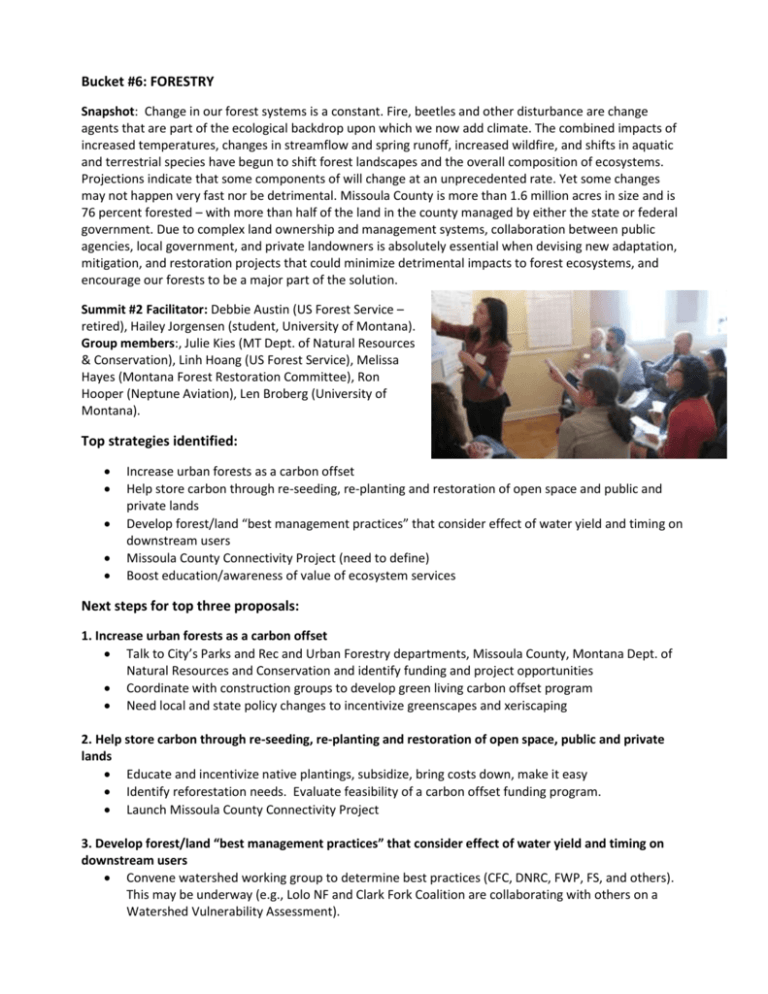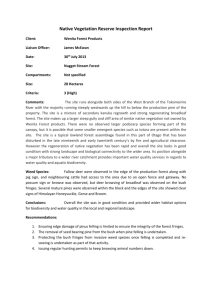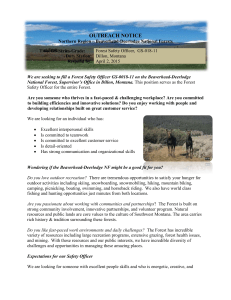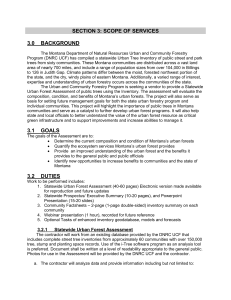Bucket #6: FORESTRY Snapshot: Change in our forest systems is a
advertisement

Bucket #6: FORESTRY Snapshot: Change in our forest systems is a constant. Fire, beetles and other disturbance are change agents that are part of the ecological backdrop upon which we now add climate. The combined impacts of increased temperatures, changes in streamflow and spring runoff, increased wildfire, and shifts in aquatic and terrestrial species have begun to shift forest landscapes and the overall composition of ecosystems. Projections indicate that some components of will change at an unprecedented rate. Yet some changes may not happen very fast nor be detrimental. Missoula County is more than 1.6 million acres in size and is 76 percent forested – with more than half of the land in the county managed by either the state or federal government. Due to complex land ownership and management systems, collaboration between public agencies, local government, and private landowners is absolutely essential when devising new adaptation, mitigation, and restoration projects that could minimize detrimental impacts to forest ecosystems, and encourage our forests to be a major part of the solution. Summit #2 Facilitator: Debbie Austin (US Forest Service – retired), Hailey Jorgensen (student, University of Montana). Group members:, Julie Kies (MT Dept. of Natural Resources & Conservation), Linh Hoang (US Forest Service), Melissa Hayes (Montana Forest Restoration Committee), Ron Hooper (Neptune Aviation), Len Broberg (University of Montana). Top strategies identified: Increase urban forests as a carbon offset Help store carbon through re-seeding, re-planting and restoration of open space and public and private lands Develop forest/land “best management practices” that consider effect of water yield and timing on downstream users Missoula County Connectivity Project (need to define) Boost education/awareness of value of ecosystem services Next steps for top three proposals: 1. Increase urban forests as a carbon offset Talk to City’s Parks and Rec and Urban Forestry departments, Missoula County, Montana Dept. of Natural Resources and Conservation and identify funding and project opportunities Coordinate with construction groups to develop green living carbon offset program Need local and state policy changes to incentivize greenscapes and xeriscaping 2. Help store carbon through re-seeding, re-planting and restoration of open space, public and private lands Educate and incentivize native plantings, subsidize, bring costs down, make it easy Identify reforestation needs. Evaluate feasibility of a carbon offset funding program. Launch Missoula County Connectivity Project 3. Develop forest/land “best management practices” that consider effect of water yield and timing on downstream users Convene watershed working group to determine best practices (CFC, DNRC, FWP, FS, and others). This may be underway (e.g., Lolo NF and Clark Fork Coalition are collaborating with others on a Watershed Vulnerability Assessment). Use output strategies and tactics (e.g., from NRAP workshops, need to define) Conduct outreach with USFS and Denver’s “Forest to Faucet” initiative to determine how program developed, strategies, obstacles, opportunities to see what might work here. Climate action strategies discussed: • • • • • • • Utilize forest resources (trees, waste) for biomass energy and work with University and other partners to implement projects. Encourage and support sustainable forestry that builds resilient habitats and watersheds, especially in the “Wildland-Urban Interface” (WUI). Partner with local government to offer education to private landowners about wildfires, fire use, and dynamic nature of ecosystems. Implement land use management techniques that reduce wildfire severity and improve forest resilience per best available science and research. Protect native species and habitats via invasive species monitoring and removal, with a focus on rehabilitation of burned areas. Showcase and support research conducted by Missoula Fire Sciences Laboratory (Fire Lab). Incorporate climate change into existing planning processes and rulemaking. Promote landscape connectivity to facilitate movement of species Establish seed banks to address shifts in habitats Adjust land use planning to account for wildfire (WUI) Value of open forest/open space – preserving and increasing (Five Valleys Land Trust, for example) Improve support for federal/state land management Use forest management to address “air sheds” Determine how to address climate issues within current regulatory process Promote building with Montana wood Use forest management byproducts for biomass Challenges: Land managers, foresters, scientists, hydrologists, and watershed managers recognize the ongoing and potential future impacts of climate change. This sector has been engaged in dynamic discussions regarding restoration and resiliency for decades, resulting in many dynamic public-private partnerships across the state of Montana and the creation of the cross-sector Montana Forest Restoration Committee. Yet this sector continues to face a unique challenge as relates to implementing new rules, coming to a shared understanding and acceptance re. management decisions, and funding projects across ownership boundaries. Hopes: Missoula community remains an excellent place to tackle these issues. We hope we continue to have public understanding and support of conservation and forestry, institution support, resources, excellent NGOs addressing these topics and trying to work across boundaries. The continued cultivation of collaboration and an involved community. Natural resources and their proximity inspire us to keep finding solutions. Involve others with expertise including…. Contact persons: Debbie Austin dlaustinconsulting@gmail.com and Hailey Jorgensen hailey.jorgensen@umconnect.umt.edu











